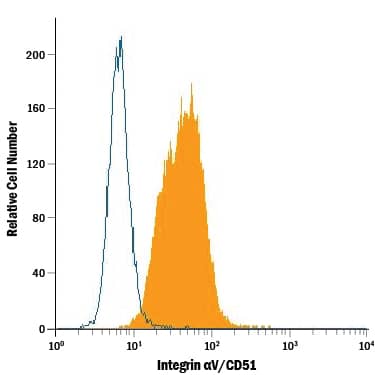Human Integrin alphaV/CD51 Alexa Fluor® 488-conjugated Antibody
R&D Systems, part of Bio-Techne | Catalog # FAB1219G


Key Product Details
Species Reactivity
Validated:
Cited:
Applications
Validated:
Cited:
Label
Antibody Source
Product Specifications
Immunogen
Specificity
Clonality
Host
Isotype
Scientific Data Images
Detection of Integrin alphaV/CD51 in HT1080 Human Cell Line by Flow Cytometry.
HT1080 human fibrosarcoma cell line was stained with Mouse Anti-Human Integrin aV/CD51 Alexa Fluor® 488-conjugated Monoclonal Antibody (Catalog # FAB1219G, filled histogram) or isotype control antibody (Catalog # IC002G, open histogram). View our protocol for Staining Membrane-associated Proteins.Applications
Flow Cytometry
Sample: HT1080 human fibrosarcoma cell line
Formulation, Preparation, and Storage
Purification
Formulation
Shipping
Stability & Storage
- 12 months from date of receipt, 2 to 8 °C as supplied.
Background: Integrin alpha V/CD51
Integrin alphaV (CD51), also known as Vitronectin Receptor subunit alpha, is a 140-150 kDa member of the integrin alpha-chain family of adhesion molecules. It forms disulfide-linked integral membrane heterodimers with at least five beta-chains, including beta1, 3, 5, 6 and 8. Human alphaV is a 1018 amino acid (aa) type I transmembrane glycoprotein that contains a 962 aa extracellular domain (ECD) (aa 31-992), and a short 32 aa cytoplasmic tail. The ECD contains seven FG (PheAlaGly)-GAP (GlyAlaPro) repeats that form a beta-propeller domain (aa 46-483). Furin cleavage of the alphaV ECD occurs after Gly889, generating a disulfide-linked heteromeric subunit alphaV chain. alphaV-containing integrins bind multiple ECM molecules, including vitronectin, osteopontin, MMP-2 and TSP. The ECD of human alphaV is 92% aa identical to mouse alphaV ECD.
Alternate Names
Gene Symbol
Additional Integrin alpha V/CD51 Products
Product Specific Notices
This product is provided under an agreement between Life Technologies Corporation and R&D Systems, Inc, and the manufacture, use, sale or import of this product is subject to one or more US patents and corresponding non-US equivalents, owned by Life Technologies Corporation and its affiliates. The purchase of this product conveys to the buyer the non-transferable right to use the purchased amount of the product and components of the product only in research conducted by the buyer (whether the buyer is an academic or for-profit entity). The sale of this product is expressly conditioned on the buyer not using the product or its components (1) in manufacturing; (2) to provide a service, information, or data to an unaffiliated third party for payment; (3) for therapeutic, diagnostic or prophylactic purposes; (4) to resell, sell, or otherwise transfer this product or its components to any third party, or for any other commercial purpose. Life Technologies Corporation will not assert a claim against the buyer of the infringement of the above patents based on the manufacture, use or sale of a commercial product developed in research by the buyer in which this product or its components was employed, provided that neither this product nor any of its components was used in the manufacture of such product. For information on purchasing a license to this product for purposes other than research, contact Life Technologies Corporation, Cell Analysis Business Unit, Business Development, 29851 Willow Creek Road, Eugene, OR 97402, Tel: (541) 465-8300. Fax: (541) 335-0354.
For research use only